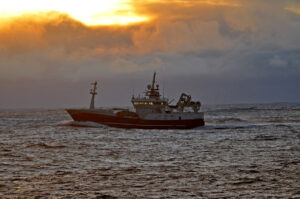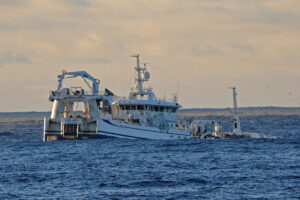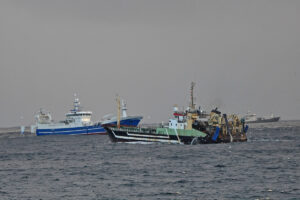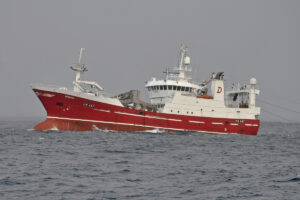As mackerel in the North Atlantic begin their customary early-year practice of swimming strongly into the southwest along the deepwater edge west of Scotland, David Linkie looks back eight years to a trip on the Peterhead midwater trawler Pathway PD 165
Having finished landing at Peterhead early the previous afternoon, the 66m Pathway – built by Simek AS in 2003 at Flekkefjord, Norway – arrived in the vicinity of mackerel grounds 30 miles northwest of the Butt of Lewis in the early hours of the following morning.

01 The 66m midwater trawler Pathway.

02 Graphic evidence of mackerel being the most abundant and valuable fish stock in UK and EU waters.

03 Keeping clear of the main concentration of mackerel by targeting small fringe marks.

04 More fish enter the net shortly after the first egg is activated.

05 A new bag, with catch sensors in place, about to be shot in the early hours of a January morning.

06 Starting to shoot away the bag.

07 Guiding the mouth of the trawl off the main drum.

08 Walking the footrope chains towards the stern.

09 Ocean Venture steams past to shoot, backlit by weak midwinter sunlight.

10 The Shetland midwater trawler Serene towing southwest of Pathway.

11 Starting to haul the sweeps on Chris Andra.

12 Pathway ready to turn back on the first leg of the tow, after hauling the doors back to the quarter.

13 Hauling underway on the German freezer trawler Annie Hillina, while Kings Cross brings the doors to the gantry, and a second Fraserburgh pelagic vessel, Krossfjord, continues towing.

14 Sunbeam towing south, as Pathway tows into the northwest.

15 The Hull-registered freezer trawler Atlantic Princess towing for mackerel 30 miles from the Butt.
As some 20 sets of navigation lights became steadily more apparent, Pathway’s Bridgemaster radars provided a reminder of the international nature that continues to be a key characteristic of the early-year mackerel fishery west of the Hebrides.
In addition to 10 Scottish pelagic vessels searching for suitable marks, the group of boats within a 15-mile radius included the Kilkeel pair-team of Havilah and Stephanie M, five Irish vessels, Antarctic, Celtic Quest, Eternal Dawn, Sheanne and Western Endeavour, and the Dutch and German freezer trawlers Alida, Annie Hillina, Atlantic Princess, Helen Mary, Jan Maria, Maartje Theodore and Willem Van Der Zwan. Further diversity within an already eclectic mix of vessels was provided by the presence of the Scottish twin-rig groundfish trawlers Caledonia, Carina, Prospect and Radiance, along with the Orkney vivier-crabber Heather K.
Watching continual dense concentrations of mackerel on the sounder display while steaming mile after mile in the early hours of a winter’s night provided indisputable proof of the importance of the western mackerel stock.
The huge marks of mackerel did not come as a total surprise, as skippers had been talking about a dense concentration of fish in reports received 12 hours earlier, while Pathway was crossing the Moray Firth at 14 knots. Seeing is believing, however, and the displays on the sounder provided evidence of what eight years later continues to be an extremely healthy stock. With ongoing sensible management in line with scientific advice, this clearly has the potential to support not only the current generation of pelagic fishermen in the near future, but – probably of greater significance – future generations as well.
It quickly became apparent that the midwater fleet had split into two groups several miles apart. Leaving the first cluster of mainly freezer trawlers astern while heading into the northwest, Pathway skipper Georgie Buchan explained that the reason for the separation was a huge mark of mackerel lying between the boats. Given the almost inevitable outcome of suffering extensive damage to their gear due to the high volume of fish, skippers were avoiding this at all costs.
The full extent of the mark quickly became apparent on the displays from Pathway’s Kaijo sonars and Simrad sounders. Some seven miles long and two miles wide and up to 80 fathoms deep in parts, the single mark was covering over 14 square miles of seabed. Viewed first-hand, this huge swathe of fish – which, it should be noted, was just one of a number of marks known to be situated between Rona and the Butt – provided dramatic evidence of just how healthy, and valuable, the mackerel stock is.
With such high concentrations of mackerel known to be in a relatively small area, it was surprising, and also disappointing, not to see any fisheries research vessels working in the area, given the advances in recent years with regard to estimating and surveying stock levels using modern underwater acoustic equipment.
After leaving the big no-go mark astern to search along the western edge for a possible fragmented, and therefore fishable, mark, Georgie Buchan said that such concentrations of mackerel, which probably exceeded 1m tonnes, were normal in early January, when the main run of fish was moving steadily into the southwest from Shetland waters. At the start of each year, the mackerel tend to gather in a deeper-shaped basin, which is surrounded to the south by a shallower horseshoe-shaped edge. The presence of what could appear to be a barrier seems to deter the fish, with the result that they turn back into the deeper basin, where they congregate with mackerel that are swimming down from the north behind them.
With bigger, physically stronger and faster-swimming mackerel usually found at the front of the migratory travel, the resultant milling of fish, when all sizes tend to become mixed, can result in a difficult first two weeks of the fishery. This is compounded by the fact that skippers are trying to familiarise themselves with the behaviour pattern of the fish. This, in turn, can be exacerbated by not knowing how fish will react to the presence of boats again, after two months of very little fishing effort following the end of fishing in Shetland waters in October.
As dawn began to grey the night sky, Georgie Buchan weighed up the option of shooting on one of several marks viewed as possibilities along an edge of ground that could yield bigger fish. Having considered whether to go at first light or wait, the decision for action was taken. The ‘away to shoot’ call on the intercom resulted in the crew donning their deck gear and hard hats before making their way aft, where the bag was already laid out on the trawl, with freshly charged deck sensors in place.
Following a final pass over the mark to verify speed and direction of travel, the out-hauled bag was released. With shooting away – including positioning the Simrad FS-70 trawl sonar transducer securely in the headline pocket – proceeding smoothly, the crew prepared to clip on the double toe-end weights (2 x 1.1t) as the last sections of the net came off the drum, followed by 150m of 32mm-diameter nylon-covered Dyneema sweeps.
After connecting the sweeps to the Net Systems 12.5m2 Extra trawl doors and retrieving the pennants, chief John Hendry started to release 600m of 38mm trawl wire from the wheelhouse fishing console, as Pathway started to tow the gear at 4.2 knots, with 70% load and pitch on the Wärtsilä 12V32 main engine (5,280kW @ 684rpm) and 3,800mm-diameter CP propeller respectively.
Because of the big marks of mackerel that had been a feature of recent years, skipper Georgie Buchan had opted to downsize Pathway’s midwater trawl in order to reduce fishing effort and have a more controlled fishery. As a result, the new net had a circumference of 1,330m – considerably less than the previous one, which measured 1,680m. Made in Peterhead by Jackson Trawls, the smaller, stronger and more controllable trawl, which was designed to consider the impact of fish hitting the tunnel, featured 25.6m meshes in the wings constructed from Van Beelen 12.6mm-diameter twisted three-strand nylon, stronger selvedges and easily replaced sections. The net typically gave a spread of 60-70 fathoms and a headline height of 25-28 fathoms.
Towing southwest in 107 fathoms, the sounder was quickly displaying light fluffies of marks standing 20-25 fathoms off the bottom. Having shot a few minutes earlier, the Shetland and Fraserburgh boats Serene and Chris Andra were towing on a similar heading either side of Pathway, while Kings Cross, Krossfjord and Ocean Quest were preparing to shoot less than half a mile astern.
Thirty minutes after shooting, the first mackerel came to the mouth of the trawl, as displayed by a couple of sweeps of the net sonar. A few minutes later, the first catch sensor, positioned to show 50t of fish and confirm that the net was fishing correctly, was triggered.
In looking for bigger fish, the Scottish boats were working the extreme leading edge of fragmented marks moving west, with skippers reporting relatively small amounts of mackerel coming to their nets.
On moving into clear water 45 minutes later, the leading trawler Serene was the first boat to haul, with skipper Bobby Polson subsequently reporting an acceptable 270t of 370g fish. Having held a more southerly course, Chris Andra also started to haul, with the trawl sensors indicating a similar quantity of fish.
Skipper Georgie Buchan was hoping to be able to land a half shot of fish in Peterhead the following morning that would meet in-house processing requirements for the rest of the week. He therefore hauled the doors back to the quarter before turning Pathway back along the first leg towards the same mark, which was found to have moved into the east after daylight strengthened, rather than losing time looking for fresh marks.
Again keeping well clear of the huge spread of fish stretching away to starboard, a succession of small but potentially viable light marks began to appear on the sonar. Similar echoes were reported by Sunbeam skipper James Duthie, towing on a reciprocal course a berth into the west.
Gradually the marks firmed up slightly. As they were located over the bottom 20 fathoms, the propeller pitch was constantly adjusted to keep the footrope positioned just off the seabed.
The German freezer trawler Annie Hillina heaved up for a second time that morning just ahead of Pathway, before moving two miles into the northeast, where the Atlantic Princess was already towing.
Although the second catch egg indicating 150t had been showing for a while, activity at the net was slow for the next 30 minutes, before a more promising-looking sign of fish appeared slightly to port on the sonar. With suitable course adjustments made, the mark, which was lying tighter to the bottom than any others so far, was successfully tracked back to pass under the boat, when the deeper red colours displayed created a buzz of excitement in Pathway’s wheelhouse.
Twenty minutes later, several successive sweeps of the net sonar revealed fish at the net. As a result of the third and fourth catch sensors going off in quick succession a few minutes later, the auto-trawl mode was changed to heave on the Karm autotrawl system, and the Karmøy 82t split trawl winches started to haul the midwater trawl doors back to the gantry. This enabled the crew to clip on the G-links of the helper pennants, before the forward and lower 50t net drum started to wind o
n the 150m sweeps, followed by the toe-end weights and the net.
As the 50t lifeline winch shortened the 490m new-tech polypropylene 10in-diameter lifeline, which included a 30m section of nylon next to the bag for stretch, the bag was dried up by the net drum. The midline choker was then pulled by the purse winch and Pathway came round on the gear as the bag was hauled to the forward gallows by the purse dahn wire winch. The lifter section of the brailler was then taken aboard and clamped in position over the 18in inlet of the 24in Karm fish pump, which could deliver 10t of fish per minute to the MMC Tendos fish/water separator.
In order to maintain the fish in prime condition, five of Pathway’s 12 RSW storage tanks had earlier been filled with 600t of seawater and chilled down to -2ºC to ensure that the catch would be quickly cooled to the optimum temperature, which would be maintained at that level until completion of landing.
With practised ease, the crew quickly lowered the fish pump into the water, and a few minutes later the first mackerel started to cascade down the forward chute. As pumping continued, a large pod of around 30 to 40 orca whales spanning several generations moved in towards Pathway’s starboard side, in anticipation of an easy supper when the pump was removed and the bag hauled back to the stern. A great sight to see, the sea mammals provided further evidence of the ability of the North Atlantic to support a wide array of sustainable stocks.
The first mackerel to appear in the chute were immediately scooped into a fish basket and passed down to the pumping control room to be individually weighed on a set of Marel electronic scales. While a large percentage of the fish averaged between 370g and 390g, a sprinkling of smaller mackerel pulled the overall average weight down towards 340g. The positive take on this mix of sizes was that the smaller mackerel clearly represented strong levels of stock recruitment, providing further evidence of what is undoubtedly an extremely healthy stock, as well as a valuable national asset.
With Pathway’s catch destined for in-house processing and marketing, sales outlets were already in place for the more diverse than usual sizes of fish, which would be graded at Peterhead 24 hours later.
However, notwithstanding this flexibility, the drop in price structure experienced in the previous 18 months, together with reduced access to an increasing stock, had ramped up pressure on skippers to gain maximum value from their quota by landing bigger fish whenever possible.
Skipper Georgie Buchan was confident that the mackerel would begin to move into the southwest towards the Barra Head grounds in the next few days, when bigger fish would generally be expected to separate away from the smaller sizes due to their greater stamina, when typically swimming 25-30 miles per day. This would provide more opportunities for boats fishing at the front of the main run of fish to catch a more uniform size of larger mackerel.
Shortly after 1pm, Georgie Buchan set a course towards the Pentland Firth and Peterhead with 500t of mackerel aboard. Following a warming bowl of homemade lentil soup as they came in off the deck, the crew enjoyed a fine supper of chicken Maryland with all the trimmings later in the evening, as Pathway was passing Loch Eriboll.
When Pathway returned to the grounds five days later, as expected the mackerel had resumed their migration, moving 100 miles from northwest of the Butt to southwest of St Kilda. This movement also resulted in the anticipated natural size separation of the shoals, with boats taking shots of 400-430g fish from short tows.
With the fish swimming up to 35 miles in some 24-hour periods, the fleet was fishing midway between Barra Head and Tory Island off the coast of Co Donegal, almost 300 miles from where the first and second shots of the year had been taken off the Butt, when Pathway took her fourth and final shot of big 480g fish from the early-year mackerel fishery.
That the Scottish midwater fleet was tied up again before the end of January, having taken most of its allocated fish west of 4º, provided indisputable evidence of the benefits of fishing the mackerel stock at a time of year when fish are in prime condition, and are caught with the minimum of sea time and carbon footprint.
Apart from minor annual variations, this well-established pattern of fishing has prevailed for the subsequent eight years, as mackerel stocks hold true to their customary migratory instincts before spawning in the Bay of Biscay.








